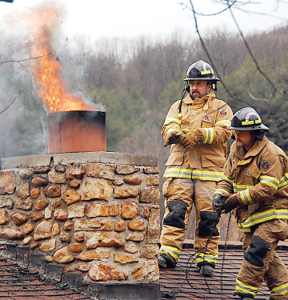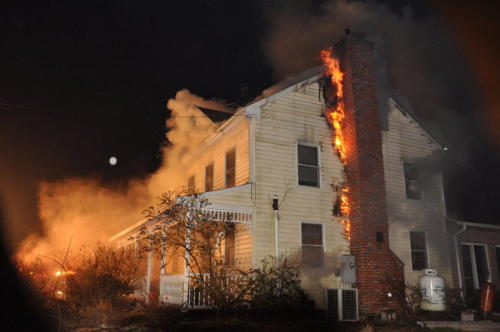IMPROPER USE OF FIREPLACE
Improper Use of Fireplace or Heating Appliance
- In this section we will highlight some of the DO’s and DO NOT’s of starting a fire in your masonry fireplace or heating appliance. Fire safety is crucial to preventing accidents and improper use is a major fire hazard to avoid.
-

- Improper Use of a Masonry Fireplace
-

-
Starting a fire is an adult activity and children should always be supervised if they are in the same room as the fire. Check to make sure the damper is open before starting your fire. Do not allow fans to blow directly into fireplace. Avoid any drafts that alter burn flame patterns. Never burn any of the following in your fireplace: paper, Christmas trees, green wood, flammable liquids, trash, cardboard, or other materials that are difficult to control in your confined space. Not only could these materials burn out of control, some of these materials such as green wood will also cause increased levels of creosote to build up which will require removal. Never close your damper when hot ashes are still in your fireplace; make sure your ashes are completely cool before closing the damper. If you close the damper prior to the fire fully cooling, you risk reheating your fire or forcing carbon monoxide into your house because it can no longer draft properly. Disposing ashes should be done when they are completely extinguished, which can take several days. Put ashes in a closed metal container, soak them in water, and make sure you store the container away from combustible materials.
- Improper Use of a Prefabricated Fireplace
-
-
If you have a prefabricated fireplace, keep in mind that it is not intended to be your primary source of heat during the winter because it is not designed to handle long term fires or high heat. When starting a fire, make sure you understand the mechanics of your system. You must make sure the dimensions of the prefab you are using has adequate clearance between the fire box and your home's wood framing. A typical problem that chimney sweeps encounter with prefabs is improper clearance to combustibles or improper selection of manufactured components which means the owner did not follow the listed components in the manufacturer’s instructions. You should follow the manufacturer’s manual for your fireplace word for word (no shortcuts or exceptions) and if you no longer have it, it’s a good idea to get your fireplace recertified to make sure it meets the state law safety standards because prefabs have a limited lifespan. Do not store or use gasoline or other flammable vapors and liquids in the vicinity of your prefabricated fireplace or any other heating appliance.
- What to do if you Detect a Fire in your Home
-
Any of the common hazards described on this website has the potential to cause a house fire. If you're home when the fire occurs, you'll likely hear it before you see anything. If you hear a loud, roaring noise that grows louder as you approach your chimney immediately gather your family and exit your house. The loud noise is due to the increasing amounts of air being pulled in to feed the fire. (If you can safely do so, you can close the doors on the fireplace or the draft controls on the wood stove before exiting but DO NOT get this close if it is unsafe!) When you go outside, you will see clouds of dark smoke exit the chimney, often accompanied by sparks or flames. Call the fire department from a neighbor’s house or outside from a safe distance from your chimney on your cell phone. If it is possible, you can use a hose and wet the roof surrounding the chimney, but don't get water directly on the hot chimney as this can cause greater damage. The fire department will work to put out your fire for you. After, be sure to contact your certified chimney sweep to assess the damage and make repairs. Also, report the fire to your insurance company along with a copy of the inspection report and repair estimates. Do not use your fireplace again until complete repairs have been made.
- Proper way to start a Fire in your Fireplace
-

- 1. First and foremost, have your fireplace inspected annually and cleaned when necessary by a chimney sweep certified by the Chimney Safety Institute of America.
- 2. Clear the area around the fireplace and chimney. Debris too close to the fireplace could cause a fire. Check the flue for obstructions like a clump of leaves, and trim any overhanging branches or large trees near the exterior of your chimney.
- 3. Always use a fireplace screen. Kids and pets should still be supervised when a fire is lit but the screen is added protection.
- 4. Never overload the fireplace with too many logs (or anything that is not a log).
- 5. Keep a fire extinguisher on hand. See that the extinguisher is in good working order and that all family members know how to operate it. Also, install a carbon monoxide detector and smoke detectors throughout the house. Test the detectors and batteries regularly.
- 6. When building a fire, place logs at the rear of the fireplace, preferably on a grate.
- 7. Always stay attended to your fire while it is lite. Be sure the fire is extinguished before you leave the room for the night.
- 8. Keep extra wood stacked, covered, off the ground and outside. Bring in only as much as you need for one use to prevent insects that may be in the wood from entering your home. You can buy manufactured fire logs, which are packaged to eliminate insects and mess.
- 9. Dispose of ashes properly. Make sure ashes are fully extinguished (could take several days) and put them in a closed metal container. Add water to the container and keep it away from your house to avoid fires.
- Improper Usage and Care of a Wood Burning Stove
-

-
Controlled draft stoves and fireplace inserts generate excessive air pollutants if operated improperly. A common, but highly improper operating procedure involves fully loading the stove or insert with wood and restricting the air flow through the unit by almost closing the draft controls. This creates a cooler, slower burning fire that produces a great deal of smoke. The smoke has lower combustion efficiency and increased creosote deposits on your chimney walls. On the flip side of this, keeping your damper wide open while trying to heat the room will allow too much airflow into the firebox to heat up the area sufficiently, even though the flame is raging. You’ll use up your wood faster and get less heat if the airflow is too intense. Another common improper practice is using green wood to heat the stove. Only hot, dry wood should be used in a wood burning stove, otherwise, it will not start or heat properly. I good rule of thumb is to allow wood to sit for one year after harvesting it before burning it.
- Improper Chimney Ventilation
-
Proper chimney venting occurs naturally because of the temperature difference between the air outside verses inside your chimney. Hot air produced by the fire forces hot air to flow up through the chimney and out; this is known as draft. It works because hot air is less dense than cold air, so it rises. Things people do to prevent proper chimney ventilation include:
-Forgetting to open the damper before starting a fire (smoke will get everywhere inside your living space!)
-Not having a chimney cap
-Using their fireplace that is clogged with creosote, or other debris such as an animal nest
-Installing a heating appliance to a chimney that is not sized appropriately for the unit
-Burning objects other than dry wood and starter logs in their fireplace; ie: cardboard
